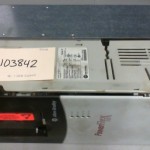Are you looking to save energy? Trying to gain speed and torque control? Wishing you could control your starting current? Variable speed or frequency drives can do just that and much more. Read on for benefits, maintenance, and troubleshooting tips for VFDs.
Benefits of a VSD/VFD include:
- Reduces power line fluctuations which eliminates voltage sags
- Controls stops which reduces mechanical wear and breakage
- Adjusts operating speed which can optimize the process
- Eliminates mechanical components such as gearboxes by letting the motor and drive handle the speed and torque needs
- Reduces power demand during startup which can cut utility charges for demand factors and power factor penalties
- Controls starting current by starting your motor with 50%-70% of the full-load current, plus extending the life of the motor by reducing the startup current
- Collects data to detect motor, drive and wiring problems, deterioration of driven equipment, changes in process conditions, energy consumption, and much more
Most drive manufacturers have modeling software that lets users see the impact using a drive will have on their system. This is often a free service on their websites so you don’t have to call in a sales rep until you are ready.
VFDs are hardy workhorses. Some manufacturers advertise 200,000+ hours of mean time between failures. So how much maintenance does that take? Actually, VFD maintenance is not too complicated. Like all of your valuable equipment, it will need regular maintenance.
The major VFD maintenance rules are:
- Keep it Dry: Moisture is kryptonite to electronics so keeping your VFD dry is critical. If you run your VFD every day, the normal radiant heat from the heat sink should prevent any potential condensation. Use a dehumidifier if needed but make sure the water collected by the dehumidifier is kept well away from electronics. You can also use a thermostatically controlled space heater in damp or condensation-prone areas.
- Keep it Clean: Dirt is the other kryptonite for electronics. Dust and dirt on a VFD can cause a lack of airflow which can result in diminished performance and the dreaded overheating which usually ends badly. Those little dust particles can also cause stray current paths which ends badly also, usually with a loud “bang”. Dust actually absorbs moisture so the more dirt you allow to build up, the more moisture is trapped creating the setting for equipment failure. Spraying air through the heat sink fan is a good maintenance technique to help with this. If you use compressed air for cooling it must go through a super dryer. And make sure the compressed air is oil-free and non-static generating to avoid electrostatic discharge.
- Keep the Connections Tight: You might be surprised how often loose connections (and overly tight connections) contribute to erratic performance, scrap, machine damage, machine failures and even personal injury (so much so that I wrote an entire article on the subject). Use caution when retorquing the connections. Use a thermal camera or digital pyrometer (get one if you don’t have one, this is important) and check the VFD under load. If any connections show hot, then shut it down and check the torque with a torque wrench or screwdriver. Do not over tighten.
Vibration and heating/cooling cycles contribute to bad connections which then lead to arcing. Arcing in a VFD input can cause incorrect over voltage faults, damage to components, and clearing of input fuses. Arcing at the output can damage components and cause over-current faults.
Having trouble with your VFD? If you don’t think any of the above maintenance rules were the problem, then here are few troubleshooting tips for VFDs :
- Inspect the components. Look for bulging or leaking DC bus capacitors. These could be signs of aging or overstressed components and need to be replaced. Check the date codes on the capacitors too. These date codes are pretty accurate and aging capacitors is a common cause of trouble.
- Check the fans. Look and listen for signs of bearing failure or foreign objects.
- Take voltage measurements with the VFD in operation. Your manufacturer will have measurement guidelines for this. Problems with the voltage can indicate many things including bad capacitors, bad diode bridge, and transistor leakage all of which need immediate repairs.
- Check heat sink temperatures often, weekly is best but monthly will work. You will most likely have a direct temperature readout on the keypad or display to make this an easy check. A VFD is essentially a computer and extreme temperatures are always bad news for computers.
Still having problems with your VFD? If it’s still under warranty, contact your OEM. If it is out of warranty, contact an independent industrial electronic repair center. They should offer free evaluations for your VFD and, if needed, a free quote for repairs. They should also provide repair reports and a good warranty that covers both parts and labor.
About the Author: ACS Industrial Services is an independent industrial electronic repair center providing repair services for drives of all types including vf drive repairs, servo motors, encoders, printed circuit boards, monitors and touchscreens, PLCs, test equipment, and much more. Our customer service team is available to answer your questions and help solve your industrial electronic repair concerns. You can reach them by calling 800-605-6419.

